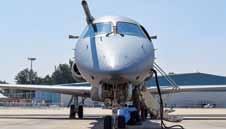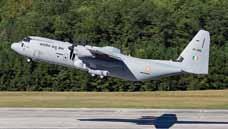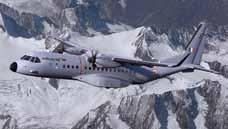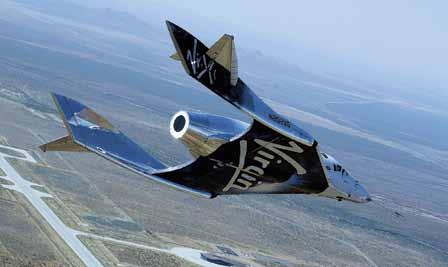
17 minute read
NewsDigest
MILITARY
ASIA-PACIFIC
Advertisement
CABINET COMMITTEE ON SECURITY CLEARS SIX AEW&C AIRCRAFT
The Cabinet Committee on Security (CCS) chaired by the Prime Minister Narendra Modi in a meeting on September 8, 2021 has approved a `10,990 crore ($1.5 billion) indigenous project to build six airborne early-warning and control (AEW&C) aircraft to expand the aerial surveillance capability of the Indian Air Force (IAF). The AEW&C system has been developed by the Defence Research and Development Organisation (DRDO) which will involve mounting indigenous 360-degree coverage Active Electronically Scanned Array (AESA) radar on six Airbus 321 passenger aircraft to be acquired from the existing Air India fleet. The first flight trial of the AEW&C aircraft is expected in four years and the entire project being completed in seven years. At present, the IAF has only three Israeli Phalcon AWACS mounted on Russian IL-76 transport aircraft, with 360-degree radar coverage at a 400 km range and two indigenous “Netra” AEW&C systems with 240-degree coverage radars having a range of 250 km range, fitted on smaller Brazilian Embraer-145 jet platform. There was thus an urgent requirement to boost the 360 degree aerial surveillance coverage of the country. Electronics and Radar Development Establishment is responsible for the design of the radar array. The Defence Electronics Application Laboratory is responsible for the Data Link and Communication Systems for AEW&CS.
In March 2021, the Ministry of Civil Aviation (MoCA) published the Unmanned Aerial System (UAS) Rules, 2021. The existing regulations were perceived by the end users and stake holders as being restrictive in nature as they involved considerable paperwork, required permission for every UAS flight and very few “free-to-fly” green zones were available. Based on the feedback, the Government decided to repeal the UAS Rules, 2021 and replace these with the liberalised UAS Rules, 2021 which were posted by MoCA on August 26. There are 30 key features like the rules are built on a premise of trust, self-certification and non-intrusive monitoring. The Government aims to become a global UAS hub by 2030 due to India’s traditional strengths in innovation, information technology, frugal engineering and huge domestic demand.
LOCKHEED MARTIN AWARDED 5-YEAR CONTRACT TO SUPPORT IAF’S C-130J SUPER HERCULES FLEET

On August 24, 2021, Lockheed Martin was awarded a $328.8 million, fiveyear contract to provide dedicated and comprehensive support for the IAF’s fleet of 12 C-130J-30 Super Hercules Aircraft. Lockheed Martin is the original equipment manufacturer (OEM) of the C-130Js which is the tactical airlifter of choice for 26 operators in 22 nations. Through this Follow On Support II (FOS) contract, Lockheed Martin teams manage the programme, logistics and engineering support elements necessary to sustain the IAF’s C-130J fleet. The contract spans a five-year-period, is a Direct Commercial Sale and is a continuation of a prior five-year FOSI.
INDIA AND US SIGN PROJECT AGREEMENT FOR AIR-LAUNCHED UNMANNED AERIAL VEHICLE
As per a notification MoD of September 3, 2021, India’s MoD and US Department of Defence have signed a Project Agreement (PA) for Air-Launched Unmanned Aerial Vehicle (ALUAV) under the Joint Working Group Air Systems in the Defence Technology and Trade Initiative (DTTI) on July 30, 2021. The PA for ALUAV falls under the Research, Development, Testing and Evaluation (RDT&E) MoA between the MoD and US Department of Defence, which was first signed in January 2006 and renewed in January 2015. The PA for co-development of ALUAV has been overseen by the Joint Working Group on Air Systems and is a major accomplishment for DTTI. The PA outlines the collaboration between US Air Force Research Laboratory, IAF and DRDO towards design, development, demonstration, testing and evaluation of systems to co-develop an ALUAV Prototype. Specific establishment from India is Aeronautical Development Establishment and from US is the Aerospace Systems Directorate.
PROCUREMENT OF 56 C295 TRANSPORT AIRCRAFT FOR THE IAF

The CCS approved the procurement of 56 C295MW transport aircraft from Airbus Defence and Space, Spain for the IAF on September 8, 2021. The C295MW is a transport aircraft of 5-10 tonne capacity with contemporary technology that will replace the ageing Avro aircraft of the IAF. The aircraft has a rear ramp door for para dropping of troops and cargo. Sixteen aircraft will be delivered in flyaway condition from Spain within 48 months of signing of the contract and forty aircraft will be manufactured in India by TATA Consortium within ten years of signing of the contract. This is the first project of its kind in which a military aircraft will be manufactured in India by a private company. All fifty six aircraft will be installed with indigenous Electronic Warfare Suite. The project will give a boost to aerospace ecosystem in India wherein several Indian MSMEs will be involved in manufacturing of parts of the aircraft. Before completion of deliveries, ‘D’ Level servicing facility (MRO) for C295MW aircraft will be setup in India. It is expected that this facility will act as a regional MRO hub for various variants of C295 aircraft. This is a major boost to Atamnirbhar Bharat.
AMERICAS
LOCKHEED MARTIN TO PARTNER TATA ADVANCED SYSTEMS FOR PRODUCING F-21
Michael Kelley, Vice President – India for Lockheed Martin Aeronautics Technique and Enterprise Growth and Brett Medlin, the F-21 India Marketing campaign head, were in India for conferences with the
APPoIntMEntS
AIR MARSHAL B.R. KRISHNA APPOINTED CHIEF OF INTEGRATED DEFENCE STAFF (CISC)
Air Marshal B.R. Krishna took over as Chief of Integrated Defence Staff to the Chairman, Chiefs of Staff Committee with effect from September 30, 2021. Earlier he was the Air Officer Commanding-in-Chief (AOC-in-C) of Western Air Command which he took over on July 1, 2021. The Air Marshal was commissioned in the IAF in December 1983 as a Fighter Pilot. In a distinguished career spanning nearly 38 years, the Air Officer, being a Qualified Flying Instructor and an Experimental Test Pilot, has flown a wide variety of fighters, transports and helicopters in the inventory of IAF. He has a flying experience of nearly 5,000 hours, including operational, instructional and test flying.
AIR MARSHAL SANDEEP SINGH APPOINTED VICE CHIEF OF THE AIR STAFF, IAF
Air Marshal Sandeep Singh has taken over as the Vice Chief of the Indian Air Force on October 1, 2021. An alumnus of National Defence Academy, the Air Marshal was commissioned in the flying branch of IAF in December 1983 as a Fighter pilot. The Air Officer is an Experimental Test Pilot and a Qualified Flying Instructor. He has rich and diverse experience in operational and experimental test flying on various types of fighter aircraft and has flown about 4400 hours.
Air Marshal Amit Dev took over as Air Officer Commanding-in-Chief of Western Air Command, Indian Air Force on September 30, 2021. He was earlier heading the Eastern Air Command, Indian Air Force, Shillong, from October 1, 2020. He was commissioned into the fighter stream on December 29, 1982 and has flying experience of more than 2,500 hours on MiG-21 and MiG-27 fighter aircraft. He did his schooling from St Michael’s, Patna and joined National Defence Academy in 1979. He was commissioned in the Indian Air Force on December 29, 1982.
AIR MARSHAL DILIP KuMAR PATNAIK APPOINTED AOC-IN-C, EASTERN AIR COMMAND, INDIAN AIR FORCE
Air Marshal Patnaik took charge as Air Officer Commanding in Chief of the Eastern Air Command on October 3, 2021. He was commissioned in Indian Air Force on June 8, 1984, as a fighter pilot. He has flown a wide variety of fighter and trainer aircrafts including the Mirage 2000 and the MiG-21. He has a rich operational flying experience of over 2500 hours. In the summer of 1999, he carried out the first ever night Laser Guided Bomb strike on Tiger Hill, facilitating its recapture from the enemy. The Air Officer has held numerous important appointments. He commanded a frontline Fighter Base as an Air Commodore. As an Air Vice Marshal, Patnaik has held the coveted appointments of Chief Staff Officer (Air Vector) at HQ Strategic Forces Command and Assistant Chief of Air Staff Operations (Air Defence) at Air Head Quarters.
AIR MARSHAL VIKRAM SINGH APPOINTED AOC-IN-C, SOuTH WESTERN AIR COMMAND, INDIAN AIR FORCE
Air Marshal Vikram Singh took over as Air Officer Commanding-in-Chief, Headquarters South-Western Air Command on October 3, 2021. He was commissioned into the fighter stream on 21 December 1984. The Air Marshal flew MiG-21 and Mirage-2000 aircraft before undergoing the Flying Instructor's Course, Experimental Flight Test Course and Staff Course at Pretoria, South Africa. He has performed Flight Test duties at the National Flight Test Centre, commanded an Air Force Station, served in various staff appointments in Air Headquarters and has been the Air Attache at Moscow, Russia.
M. SuRESH TAKES OVER AS MEMBER (AIR NAVIGATION SERVICES) AT AIRPORTS AuTHORITY OF INDIA (AAI)
M Suresh has taken over the charge as Member (Air Navigation Services) at Airports Authority of India on September 2, 2021. Prior to this assignment, Suresh was holding the charge of post of Executive Director (Aviation Safety) at Corporate Headquarters of AAI and discharging the strategic function of ensuring safety in aerodrome operation and air navigations services and developing and maintaining a safety management policy of AAI.
He also worked as Regional Executive Director (North East Region) and was responsible for planning, design of modern state-of-the-art environmentfriendly airport terminals and airside infrastructure such as runways, apron and their financial evaluation, regulatory clearances, tendering and award processes.
BOEING
On August 23, 2021, the Boeing Company announced the appointment of Alexander Feldman as the new President of the company’s Southeast Asia business, effective August 27, 2021. Feldman is based in Singapore and oversees the company’s strategy and operations as Boeing expands its regional presence.
Indian authorities and the IAF on the multibillion deal that is anticipated to see the IAF procure 114 medium multi-role fight plane as reported in the media on August 12, 2021. As per Lockheed Martin, the F-21 is specifically configured for the IAF and enables unmatched ‘Make in India’ Industrial Opportunities read Atamnirbhar Mission. The F-21 demonstrates Lockheed Martin’s commitment to delivering an advanced, scalable fighter aircraft to the IAF that provides unrivalled industrial opportunities and accelerates closer India-US cooperation on advanced technologies. The F-21 features numerous India-specific changes – inside and out – tailored to meet the IAF’s requirements. Innovative technologies derived from Lockheed Martin’s F-22 and F-35 – the world’s only two operational fifth Generation fighters – strengthen India’s path to an advanced airpower future. The company has also stated that they will not export F-21 to any other country.
Representatives of Lockheed Martin also stated they had been open to setting up an upkeep, restore and MRO facility for its F-21 in India. Lockheed which is providing the F-21, is in competition with Boeing’s F-18, Swedish SAAB’s Gripen, Dassault Aviation’s Rafale, EADS’ Eurofighter Hurricane and Russia’s United Plane Company MiG-35. l
QuickROUNDUp
BOeING
Boeing’s long-awaited Starliner flight to the International Space Station (ISS) again faced a delay due to a newly attached space station module launched by Russia inadvertently started firing its thrusters, briefly pushing the space station into a spin before ground controllers got it back under control. This is Boeing’s second orbital test of the reusable space vehicle designed for regularly transporting astronauts and payloads to the ISS. The first Boeing KC-46A tanker built for the Japan Air Self-Defence Force recently refuelled another KC-46A aircraft in the skies over Washington. The Japan-bound tanker also successfully received fuel in return. Japan is the KC-46 programme’s first non-US customer and is scheduled to receive its first aircraft this year. Boeing is continuing to expand the Indian Navy's longrange maritime reconnaissance anti-submarine warfare capabilities with the delivery of the country's 11th P-8I on October 18, 2021. This is the third aircraft to be delivered under an option contract for four additional aircraft that the Indian Ministry of Defence awarded in 2016. Indian Navy (IN) was the first international customer for the P-8 and today operates the largest non-US fleet.
GeNeRAL ATOMICs
General Atomics Aeronautical Systems Inc. (GA-ASI) completed a series of flight demonstrations that featured a company-owned MQ-9B SeaGuardian® Remotely Piloted Aircraft (RPA) in partnership with the Royal Air Force (RAF). The demonstration series began August 25 and ended with the completion of the UK’s Exercise Joint Warrior on September 30. The flights showcased the many operational capabilities of the MQ-9B, including the platform’s advanced maritime Intelligence, Surveillance and Reconnaissance (ISR), Detect and Avoid System (DAAS), industry-leading endurance and interoperability with NATO partners. General Atomics Aeronautical Systems completed the transfer of two MQ-9A Reaper Block 5 Unmanned Aircraft Systems (UAS) to the US Marine Corps on October 15, 2021. The two aircraft have been operated by the USMC since 2018 under a Company Owned/ Company Operated (COCO) lease agreement in support of an Urgent Operational Need. The Reapers represent the first increment of the Marine Air-Ground Task Force (MAGTF) Unmanned Aircraft System (UAS) Expeditionary (MUX) Program of Record (POR). The transfer of aircraft includes two Ground Control Stations and associated support equipment.
HeNsOLDT
It has been reported that sensor solutions provider HENSOLDT is cooperating with Israel Aerospace Industries to supply new radars to the German Armed Forces to modernise their airspace surveillance and build up Ballistic Missile Defence capabilities. The order is for the delivery and installation of four long-range radars worth approximately 200 million Euros.
INDUCTION OF THe MRsAM MIssILe sYsTeM

Being termed as a significant
boost to India’s defence capabilities, the first deliverable Firing Unit (FU) of Medium Range Surface to Air Missile (MRSAM) System was handed over to IAF at Air Force Station, Jaisalmer in Rajasthan.
The MRSAM (IAF) is an advanced network centric combat Air Defence System developed jointly by Defence Research and Development Organisation (DRDO) and Israel Aerospace Industries (IAI) in collaboration with the Indian industry comprising of private and public sectors including MSMEs.
DRDO Chairman, Dr G. Satheesh Reddy handed over the first deliverable FU to Chief of Air Staff. During the event, DRDO and IAI officials demonstrated the capabilities of MRSAM system, as part of On-Site Acceptance Test (OSAT). The CAS affirmed that the system will bolster the air defence capabilities of the country.
The MRSAM system provides point and area air defence for ground assets against a wide range of threats including fighter aircraft, UAVs, helicopters, guided and unguided munitions, sub-sonic & supersonic cruise missiles etc. It is capable of engaging multiple targets at ranges up to 70 kms in severe saturation scenarios, informed the official statement. The missile is powered by indigenously developed rocket motor and control system for achieving high maneuverability during the terminal phase.
Appreciating the joint efforts of DRDO, IAI, various inspection agencies, public & private industry partners in developing, the Defence Minister termed the MRSAM as one of the best state-of-the-art missile systems in the world that will prove to be a game changer in the air defence system.
The new test facilities and infrastructure created in the development of this programmeare deemed to prove helpful in producing quality products for both the countries in the future. “The sub-systems being manufactured for this programme as a great example of synergy between Indian public and private sector companies,” he said.
The firing unit of the system comprises of Missiles, Combat Management System (CMS), Mobile Launcher Systems (MLS), Advanced Long Range Radar, Mobile Power System (MPS), Radar Power System (RPS), Reloader Vehicle (RV) and Field Service Vehicle (FSV).
During his address, the Minister remembered former President Dr A.P.J. Abdul Kalam, terming him a visionary who paved the way for self-reliance in defence sector, especially in the missile development programme. “Around 30 years ago Dr Kalam initiated the Integrated Missile Development Programme at a time when scientists were facing various restrictions in the field of technology. Despite all this, the success of the programme not only ensured self-reliance in missile development, but also thwarted possibility of any cross-border threat.” SP
— By Ayushee Chaudhary
VIRGIN GALACTIC’s spACeFLIGHT UNDeR FAA INVesTIGATION

Less than two months since
Virgin Galactic founder Richard Branson’s first spaceflight, the company’s future missions are on a halt. The US Federal Aviation Administration (FAA) has grounded Virgin Galactic while the agency investigates the off-course drifting of the spaceflight during its climb.
Branson flew aboard the VSS Unity on July 11, 2021 as the spaceship took its first fully crewed spaceflight. Deviation from the ship’s course was noted during its descent back to the runway, which took the spaceship beyond the FAA’s air traffic control clearance area. While the aerospace company accepted that the spacecraft dropped from the protected airspace, it stated that was for about a minute and 40 seconds due to high-altitude wind. Virgin Galactic insisted that it was a safe and successful flight, the pilots responded appropriately and no one on board was in any added danger at any point. However, the FAA is overseeing the probe and only after thorough investigation would it allow further missions since it is about people’s safety. It is all the more important here because Virgin Galactic plans on taking civilians to space in the future and make space travel more accessible.
After the successful flight on July 11, Virgin Galactic had also announced a partnership with “Omaze and Space for humanity to inspire the next generation of dreamers” and had invited people to be a part of future spaceflights. Two additional test flights were planned before the company expects to commence commercial service in 2022.
However, just when the company announced its next research mission, the FAA ban came along. On September 2, 2021, Virgin Galactic announced the manifest for the next rocket-powered test flight of SpaceShipTwo Unity from Spaceport America, which will be the first commercial, humantended research mission for the Company.
Named the “Unity 23” mission, this would have been the 23rd flight for VSS Unity. The mission planned to carry three paying crew members from the Italian Air Force and the National Research Council. The goal of the mission is to evaluate and measure the effects of the transitional phase from gravity to microgravity on the human body. Other payloads to be on board would study the effect of the microgravity environment on a range of chemical and physical properties. “By testing and evaluating physiological and technological responses in sub-orbital flight, the mission aims to produce insights relevant to current and future spaceflight systems and technologies,” the company had mentioned in the official release.
The company was targeting a flight window in late September or early October 2021, pending technical checks and weather. However, now unless FAA clears the company, no further flights would take place awaits go ahead after investigation. SP
— By Ayushee Chaudhary
QuickROUNDUp
IAI
On August 10, 2021, Israel Aerospace Industries reported that the work on the structural modification for the conversion of the first Boeing 777-300ERSF to a freighter aircraft, in partnership with GE Capital Aviation Services had started and will take about 130 days. This project is part of an approximately $400 million agreement signed in 2019.
LOCKHeeD MARTIN
On August 5, 2021, Lockheed Martin Australia was selected as one of the two companies to participate in the Royal Australian Air Force’s AIR6500 Phase 1 Project : Competitive Evaluation Process Stage 2. AIR6500-1 will provide the Australian Defence Force (ADF) with a Joint Air Battle Management System that will form the architecture at the core of the ADF’s future Integrated Air and Missile Defence capability. On August 23, 2021, Lockheed Martin reported that it had invented a new type of satellite dish technology with a wide range of use on satellites and ground terminals, including space-based 5G. The Wide Angle ESA Fed Reflector antenna is a hybrid of a phased array Electronically Steerable Antenna and a parabolic dish and increases coverage area by 190 per cent compared to traditional phased array antennas at a much lower cost.
NORTHROp GRUMMAN
The US Air Force has awarded Northrop Grumman a contract to complete the design of a next-generation, open standards-based signals intelligence (SIGINT) sensor for high-altitude intelligence, surveillance, and reconnaissance (ISR) platforms. Under the Air Force’s Global High-altitude Open-system Sensor Technology (GHOST) program, the company will deliver a design of a prototype sensor – including airborne and ground components – with an innovative, open standards-based hardware and software architecture that can be scaled and configured to fly on multiple types of manned and unmanned Air Force aircraft. As per a report dated August 6, 2021, Northrop Grumman Australia has been shortlisted as one of two potential strategic partners of the Commonwealth of Australia for the design, development and delivery of the Australian Defence Force’s Joint Air Battle Management System under the AIR6500 Phase 1 project. Northrop Grumman Corporation reported on August 6, 2021 that its RQ-4 Global Hawk Ground Segment Modernisation Programme provides a new cockpit display that enhance situational awareness for the pilot and sensor operator while improving overall mission capabilities which is on schedule to complete operational test and evaluation in October 2022. Northrop Grumman Corporation reported on July 30, 2021 that its MQ-4C Triton took to the skies for the first time in the highly upgraded multi-intelligence configuration known as integrated functional capability four. Triton is the US Navy’s premier high-altitude, long-endurance, maritime intelligence, surveillance and reconnaissance platform.










